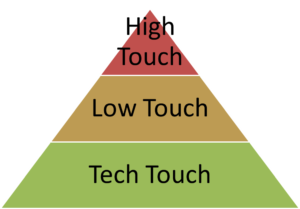High touch, low touch, tech touch: the most popular tiered account structure for Customer Success. These levels might make sense in the short term, but blind adherence can lead to a company’s decline in the long term.
Revenue maldistribution
A time comes when early-stage SaaS companies discover Pareto’s Principle—a majority of revenue comes from the minority of accounts. This “Aha!” moment then typically leads to restructuring. Internalizing this truth and facing increasing pressure to scale, Customer Success leaders stratify their operations into three categories:
- “High Touch”: large, complex enterprises obtaining regular CSM interaction
- “Low Touch”: mid-sized organizations receiving infrequent CSM interaction
- “Tech Touch”: small companies getting no CSM interaction
Customer Lifetime Value (CLTV) often guides decision making. CLTV is the difference between recurring revenue and cost to serve the customer, the result divided by account churn. When comparing customer groups, the math tends to reveal higher profitability for enterprise accounts and lower profitability for smaller, “long-tail” accounts. Customer Success leaders then use financial justification to assign their human resources to the larger customers. Then they turn their attention to automating and removing human contact from the lower tiers.
This approach makes economic sense. The 3-tier structure improves productivity by slowing hiring and increasing revenue-to-CSM ratios. And when SaaS firms compete effectively in fast-growing, undifferentiated markets, this structure helps the company scale.
But there are downsides, especially for the long term:
- Cadence becomes static. Spreadsheet logic and reactions to health scores, not changing customer needs, begin to dictate the frequency of contact. Managers soon think accounts are “entitled” to fixed schedules based on stagnant rules, for example, “every high touch account receives a monthly call.” Customers, however, require more support in the beginning and less later on, so cadence should adjust dynamically.
- Changes get awkward. Dysfunctional behaviors crop up in the gray areas between tiers. As accounts grow or shrink in revenue and managers reassign accounts to other tiers, explaining the changes can be uncomfortable. However it’s phrased, customers will smirk when their service is upgraded or downgraded based on the supplier’s internal, arbitrary rules.
- High churn becomes a self-fulfilling prophesy. Accounts with higher churn receive less attention, and because they get less attention, churn grows higher. Due to their higher revenue and greater churn impact, larger accounts garner more attention, gobbling up focus and resources necessary to counteract churn in lower tiers.
 Perhaps most troubling however, is the restructuring’s insidious impact on long-term product development. With no CSMs assigned to interact with smaller accounts, the company misses emerging growth opportunities. CSMs no longer have visibility to new problem sets, and turned off by a lack of attention, these companies switch to other suppliers. And too much attention paid to larger accounts also causes problems. When assigned CSMs lobby product managers for account-specific enhancements, “feature bloat” takes over. The product becomes more complex, harder to learn and more expensive to support. In time, the software becomes less attractive to customers large and small. Lack of differentiation makes it less desirable to smaller, specialized, growing segments, opening the door to competitors and market share erosion.
Perhaps most troubling however, is the restructuring’s insidious impact on long-term product development. With no CSMs assigned to interact with smaller accounts, the company misses emerging growth opportunities. CSMs no longer have visibility to new problem sets, and turned off by a lack of attention, these companies switch to other suppliers. And too much attention paid to larger accounts also causes problems. When assigned CSMs lobby product managers for account-specific enhancements, “feature bloat” takes over. The product becomes more complex, harder to learn and more expensive to support. In time, the software becomes less attractive to customers large and small. Lack of differentiation makes it less desirable to smaller, specialized, growing segments, opening the door to competitors and market share erosion.
Stratifying accounts based on historical revenue and internal efficiencies therefore reveals a more serious problem. Generating traction by any means necessary may get the business running, but assuming customers are all the same (save for revenue) leads to an unsustainable business strategy. Laser focus on more profitable market segments, rather than more profitable customers, becomes a mental shift that must take place to achieve long-term survival.
Focus and win
The essence of market discipline is to say “no” to some opportunities in order to say “yes” to others. In any market, certain segments grow while others stagnate or decline. Likewise, the needs of some segments represent an ideal fit for the company’s products, mission, creative passion, competitive distinction, and core competencies, while others do not. Consequently, firms should segment more intelligently, which allows them to focus on the customers offering the highest long-term growth and profit potential, regardless of their revenue history.
When product managers concentrate on high payoff segments instead of serving generic market needs, faster growth and higher profits naturally follow. And when they consider the “whole product,” that is, designing solutions to meet product and customer experience needs, Customer Success structures may look markedly different. For example, a small but fast-growing company may get more attention, rather than less, because a segment-focused CSM handles them personally. With this approach, the software company iterates solutions rapidly, keeps and expands early adopters, and quickly builds market credibility in the targeted segment.
On the surface, a 3-tiered CSM structure seems simple and obvious. But beneath the surface, it could indicate a lack of strategic focus, poor product management, or a combination of the two. Senior executives should be wary of the long-term risks and take steps to promote continuing growth in increasingly competitive and maturing markets.
